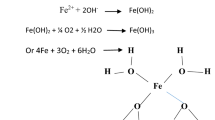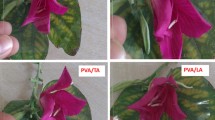Abstract
The objective of this work is to re-use of agriculture waste via an environmentally friendly procedure to introduce multifunctional cellulose-based blend films using sesame seed meal extracted from agriculture wastes. The current strategy demonstrated the identification and evaluation of the bioactive compounds of sesame seed meal extracted from agricultural wastes via an ultrasonic procedure. Then, the sesame seed meal extract was loaded onto modified carboxymethyl cellulose within a matrix of a blend film. A cross-linked blend films based on the biocompatible modified carboxymethyl cellulose (m-CMC) with phenolic compounds (Ph) extracted from sesame seed meal were developed. The cross-linked m-CMC/Ph films were investigated by Fourier transform infrared spectroscopic analysis, while the surface morphology was investigated using scanning electron microscopy. Both mechanical and swelling properties were investigated. The m-CMC/Ph film exhibited excellent antioxidant performance as well as antibacterial activity against Staphylococcus aureus as Gram-positive pathogenic bacteria and Pseudomonas aeruginosa as Gram-negative pathogenic bacteria using colony-forming unit to provide further biocompatibility for prepared blend films. Additionally, molecular docking studies were carried out on effective films to evaluate their potential interaction against P. aeruginosa LolA (PDB: 2W7Q) and S. aureus metalloproteinase (PDB:1BQB) with a binding energy of − 3.7 kcal/mol and − 2.8 kcal/mol and short bond length of 2.076 Å and 1.144 Å, respectively. The computational calculations of the optimized monomer CMC and gallic acid were carried out to elucidate the HOMO–LUMO energy gap and interaction between them as well as the optimization of m-CMC/Ph to evaluate their interaction and film stability. As a result, the present study presents a novel simple approach to design smart biocompatible films for multifunctional healthcare and medical purposes using the biologically active extracts from sustainable plant wastes.











Similar content being viewed by others
References
Abou-Zeid RE et al (2018) Novel method of preparation of tricarboxylic cellulose nanofiber for efficient removal of heavy metal ions from aqueous solution. Int J Biol Macromol 119:207–214
Dacrory S et al (2018) Antimicrobial cellulosic hydrogel from olive oil industrial residue. Int J Biol Macromol 117:179–188
Kamal KH et al (2019) Adsorption of Fe ions by modified carrageenan beads with tricarboxy cellulose: kinetics study and four isotherm models. Desalin Water Treat 165:281–289
Dacrory S et al (2019) Development of biodegradable semiconducting foam based on micro-fibrillated cellulose/Cu-NPs. Int J Biol Macromol 132:351–359
Dacrory S et al (2019) Functionalization and cross-linking of carboxymethyl cellulose in aqueous media. Cell Chem Technol 53(1–2):11
Singh R et al (2016) Lignocellulolytic enzymes: biomass to biofuel. Int J Adv Res 4(10):2175–2182
Abou-Yousef H et al (2018) Efficient alternative of antimicrobial nanocomposites based on cellulose acetate/Cu-NPs. Soft Mater 16(3):141–150
Barbucci R, Magnani A, Consumi M (2000) Swelling behavior of carboxymethylcellulose hydrogels in relation to cross-linking, pH, and charge density. Macromolecules 33(20):7475–7480
Rachtanapun P, Thanakkasaranee S, Soonthornampai S (2008) Application of carboxymethylcellulose from papaya peel for mango (Mangifera Indica L.) ‘Namdokmai’ coating. Agric Sci J 39(3):74–82
Rachtanapun P et al (2007) Production of carboxymethylcellulose (CMC) film from papaya peels and its mechanical properties. In: 45. Kasetsart University Annual Conference, Bangkok (Thailand), 30 Jan–2 Feb 2007
Khattab TA et al (2019) Development of microporous cellulose-based smart xerogel reversible sensor via freeze drying for naked-eye detection of ammonia gas. Carbohyd Polym 210:196–203
Jakobek L et al (2009) Phenolic compound composition and antioxidant activity of fruits of Rubus and Prunus species from Croatia. Int J Food Sci Technol 44(4):860–868
Alves MJ et al (2013) Antimicrobial activity of phenolic compounds identified in wild mushrooms, SAR analysis and docking studies. J Appl Microbiol 115(2):346–357
Ozcan T et al (2014) Phenolics in human health. Int J Chem Eng Appl 5(5):393
Xu P et al (2015) Sesamin inhibits lipopolysaccharide-induced proliferation and invasion through the p38-MAPK and NF-κB signaling pathways in prostate cancer cells. Oncol Rep 33(6):3117–3123
Ikeda S et al (2003) Dietary sesame lignans decrease lipid peroxidation in rats fed docosahexaenoic acid. J Nutr Sci Vitaminol 49(4):270–276
Cooney RV et al (2001) Effects of dietary sesame seeds on plasma tocopherol levels. Nutr Cancer 39(1):66–71
Khattab TA et al (2019) Smart microfibrillated cellulose as swab sponge-like aerogel for real-time colorimetric naked-eye sweat monitoring. Talanta 205:120166
Farag AM, Fahim AM (2019) Synthesis, biological evaluation and DFT calculation of novel pyrazole and pyrimidine derivatives. J Mol Struct 1179:304–314
Fu R et al (2014) Determination of phenolic contents and antioxidant activities of extracts of Jatropha curcas L. seed shell, a by-product, a new source of natural antioxidant. Ind Crops Prod 58:265–270
Kanatt SR, Arjun K, Sharma A (2011) Antioxidant and antimicrobial activity of legume hulls. Food Res Int 44(10):3182–3187
Ma Y-C et al (2016) An effective identification and quantification method for Ginkgo biloba flavonol glycosides with targeted evaluation of adulterated products. Phytomedicine 23(4), pp 377–387
De Ancos B et al (2002) Possible nutritional and health-related value promotion in orange juice preserved by high-pressure treatment. J Sci Food Agric 82(8):790–796
Sfahlan AJ et al (2009) Antioxidants and antiradicals in almond hull and shell (Amygdalus communis L.) as a function of genotype. Food Chem 115(2):529–533
Dacrory S et al (2016) Utilization and characterizations of olive oil industry by-products. Int J Environ Chem Ecol Geol Geophys Eng 10(1):91–99
Dacrory S et al (2018) Preparation and characterization of eco-friendly carboxymethyl cellulose antimicrobial nanocomposite hydrogels. J Renew Mater 6(5):536–547
Mu C et al (2012) Preparation and properties of dialdehyde carboxymethyl cellulose crosslinked gelatin edible films. Food Hydrocolloids 27(1):22–29
Fahim AM, Shalaby MA (2019) Synthesis, biological evaluation, molecular docking and DFT calculations of novel benzenesulfonamide derivatives. J Mol Struct 1176:408–421
Dacrory S, Fahim AM (2020) Synthesis, anti-proliferative activity, computational studies of tetrazole cellulose utilizing different homogenous catalyst. Carbohyd Polym 229:115537
Dacrory S et al (2020) In situ synthesis of Fe3O4@ cyanoethyl cellulose composite as antimicrobial and semiconducting film. In: Carbohydrate Polymers, p 116032
Caunii A et al (2012) Design of optimal solvent for extraction of bio–active ingredients from six varieties of Medicago sativa. Chem Cent J 6(1):123
Ma Y-Q et al (2009) Simultaneous extraction of phenolic compounds of citrus peel extracts: effect of ultrasound. Ultrason Sonochem 16(1):57–62
Dezsi Ș et al (2015) Antimicrobial and antioxidant activities and phenolic profile of Eucalyptus globulus Labill. and Corymbia ficifolia (F. Muell.) KD Hill & LAS Johnson leaves. Molecules 20(3):4720–4734
Dent M et al (2013) The effect of extraction solvents, temperature and time on the composition and mass fraction of polyphenols in Dalmatian wild sage (Salvia officinalis L.) extracts. Food Technol Biotechnol 51(1):84
Zebib H, Bultosa G, Abera S (2015) Physico-chemical properties of sesame (Sesamum indicum L.) varieties grown in Northern Area, Ethiopia. Agric Sci 6(02):238
Mohdaly AAA et al (2013) Phenolics extracted from potato, sugar beet, and sesame processing by-products. Int J Food Prop 16(5):1148–1168
Zhou L et al (2016) Phytochemical contents and antioxidant and antiproliferative activities of selected black and white sesame seeds. Biomed Res Int 2016:1–9
Nigam D, Singh C, Tiwari U (2015) Evaluation of in vitro study of antioxidant and antibacterial activities of methanolic seed extract of Sesamum indicum. J Pharmacogn Phytochem 3:88–92
Costa FT et al (2007) Susceptibility of human pathogenic bacteria to antimicrobial peptides from sesame kernels. Curr Microbiol 55(2):162–166
Hemalatha S, Rao MVV (2004) Sesame lignans enhance antioxidant activity of vitamin E in lipid peroxidation systems. Mol Cell Biochem 262(1–2):195–202
Srisayam M et al (2014) Antioxidant, antimelanogenic, and skin-protective effect of sesamol. J Cosmet Sci 65(2):69–79
Furumoto T, Nishimoto K (2016) Identification of a characteristic antioxidant, anthrasesamone F, in black sesame seeds and its accumulation at different seed developmental stages. Biosci Biotechnol Biochem 80(2):350–355
Dar AA, Arumugam N (2013) Lignans of sesame: purification methods, biological activities and biosynthesis—a review. Bioorg Chem 50:1–10
Arung ET et al (2010) Isoprenoid-substituted flavonoids from wood of Artocarpus heterophyllus on B16 melanoma cells: cytotoxicity and structural criteria. Fitoterapia 81(2):120–123
Li W-J et al (2012) Antimicrobial properties, antioxidant activity and cytotoxicity of ethanol-soluble acidic components from Ganoderma atrum. Food Chem Toxicol 50(3–4):689–694
Siqueira EJ et al (2015) Carboxymethylcellulose (CMC) as a model compound of cellulose fibers and polyamideamine epichlorohydrin (PAE)–CMC interactions as a model of PAE–fibers interactions of PAE‐based wet strength papers. J Appl Polym Sci 132(26)
Hasana H, Desalegn E (2017) Characterization and quantification of phenolic compounds from leaf of Agarista salicifolia. Herb Med 3:1–9
El-Sakhawy M et al (2018) Preparation and infrared study of cellulose based amphiphilic materials. Cellul Chem Technol 52(3–4):193–200
Singh R et al (2005) Antimicrobial activity of some natural dyes. Dyes Pigm 66(2):99–102
Bordes C et al (2019) Antibacterial properties of polyphenols: characterization and QSAR (quantitative structure–activity relationship) models. Front Microbiol 10:829
Fahim AM, Shalaby MA, Ibrahim MA (2019) Microwave-assisted synthesis of novel 5-aminouracil-based compound with DFT calculations. J Mol Struct 1194:211–226
Foresman J, Frish E (2013) Exploring chemistry. Gaussian Inc., Pittsburg
Dennington R, Keith T, Millam J (2009) GaussView, version 5, Semichem Inc., Shawnee Mission, KS. Received: May 23
Acknowledgements
The authors appreciate National Research Center, Egypt, for funding support of this work throughout the Grant Number: AR110401.
Author information
Authors and Affiliations
Corresponding author
Additional information
Publisher's Note
Springer Nature remains neutral with regard to jurisdictional claims in published maps and institutional affiliations.
Electronic supplementary material
Below is the link to the electronic supplementary material.
Rights and permissions
About this article
Cite this article
Akl, E.M., Dacrory, S., Abdel-Aziz, M.S. et al. Preparation and characterization of novel antibacterial blended films based on modified carboxymethyl cellulose/phenolic compounds. Polym. Bull. 78, 1061–1085 (2021). https://doi.org/10.1007/s00289-020-03148-w
Received:
Revised:
Accepted:
Published:
Issue Date:
DOI: https://doi.org/10.1007/s00289-020-03148-w




